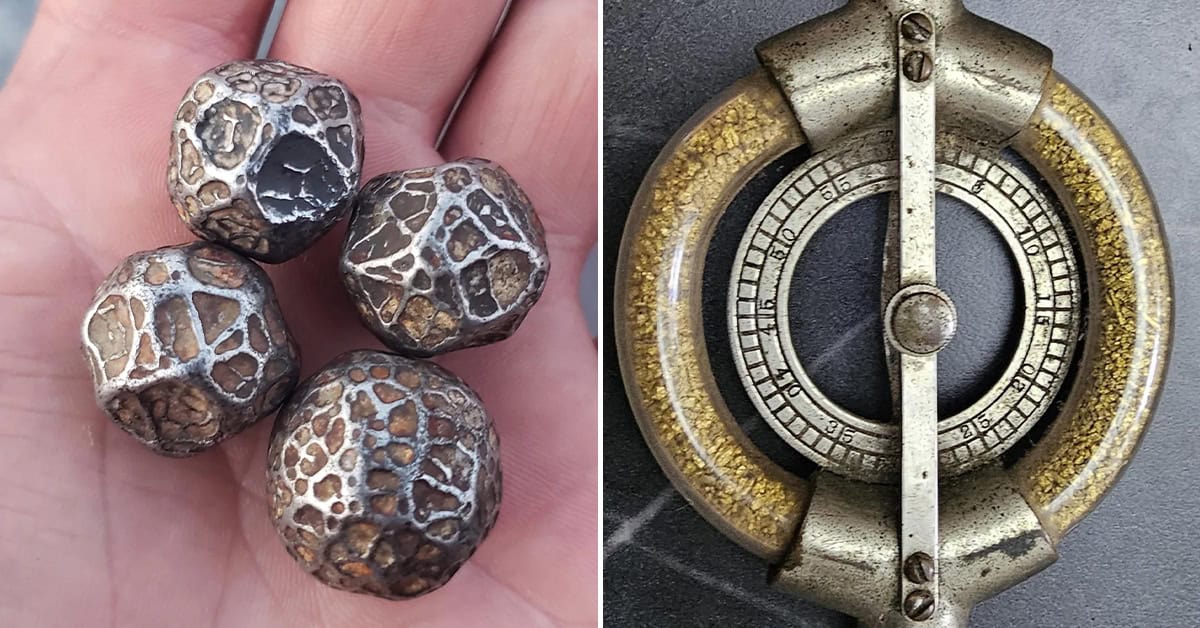“What Is This Thing?” — 25 Times People Asked The Internet To Identify Mysterious Objects This Week
Sometimes the internet is a bummer, but then sometimes a stranger will correctly identify a mysterious object you found in your basement from a random photo, and suddenly it’s the best, most helpful place on earth.
Here are the coolest times someone asked Reddit, “What is this thing?” and the internet delivered this week.
1. “What are these things under the sink in my bathroom and kitchen. Plastic piece with a button.”
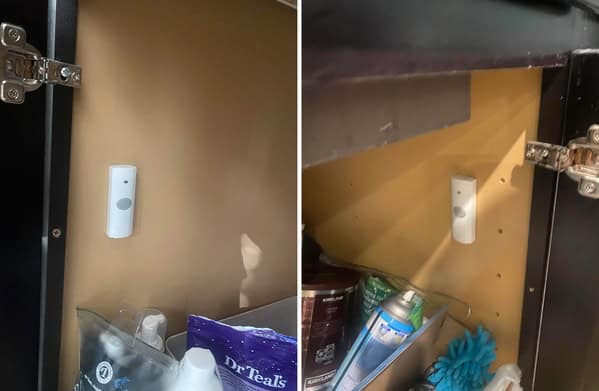
It’s a “White Wireless Unlighted Push Button”
Mystery Solved:
The button under the sink is most likely a hot water recirculation pump remote that activates a pump near the water heater so hot water reaches the faucet faster.
Other ideas came up, like wireless doorbells, panic buttons, or even an Amazon Dash-style reorder switch, but the plumbing explanation was the most convincing.
2. “Key-shaped (and sized) plastic thing. Grey button pushes in but doesn’t do anything. Found under driver’s seat”

Mystery Solved:
That key-shaped plastic piece with a grey button is part of a spring-loaded toy car launcher.
The car clips onto the “key,” locks in place, and pressing the button shoots it racing across the floor.
3. “Earthy, greasy silken bag found in my laundry”
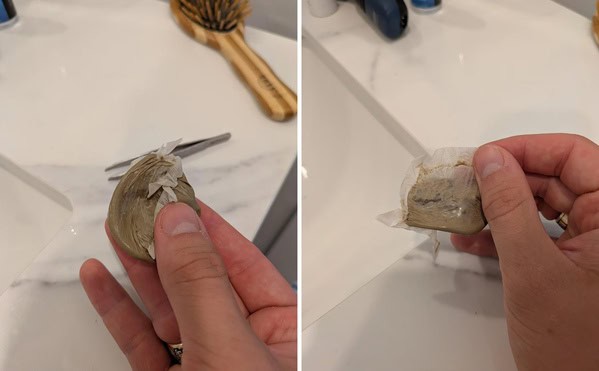
Additional Details:
“Title describes the thing. This bag of clay-like mud was found in my washing machine after running a load. It appears to be a silky baggie with some sort of plastic lining, and the content inside is a greasy mud with some chunky gravel-y bits inside.
It keeps its form well and has a spicy, early, and not unpleasant odor. I have zero earthly idea where this could have come from.”
Mystery Solved:
That earthy, greasy, silken bag found in the laundry is a bentonite clay desiccant bag.
They’re commonly packed with furniture, electronics, or textiles to absorb moisture and prevent mold or odors.
When they break down or get wet, the clay inside turns into that muddy, greasy mess they found.
4. “What is this well-crafted, wooden, 18″ tall thing that we found in a thrift store in WV, USA?”

Mystery Solved:
Identified as a Mid‑Century Modern tabletop/desk bookstand (holder shelf) designed by Mel Smilow.
It’s crafted from solid walnut and served to neatly display or support books on a desk or table.
5. “What is this thing that popped my tire? It looks like a metal top, about 1.5” in diameter.”
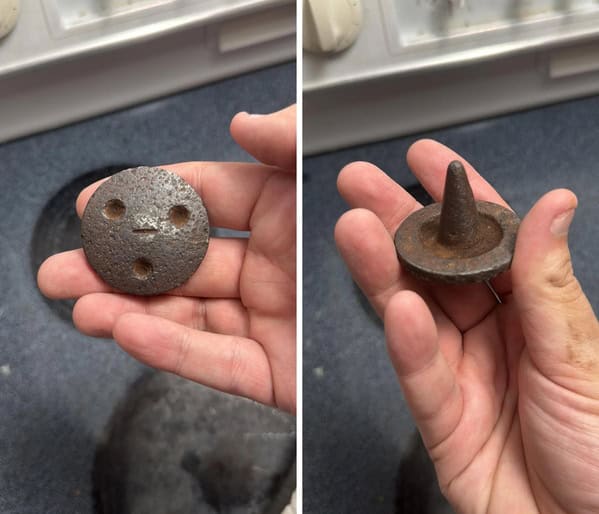
Additional Details:
This bad boy just gave my tire a good sized hole. It’s definitely metal, and is magnetic. I’d say its diameter is about an inch and half.
Mystery Solved:
The metal piece that popped the tire is actually part of a one-way valve from a hand water pump. It works as a simple check valve, letting water flow in one direction while blocking it the other way.
Over time these parts can break loose, end up on the ground, and in this case, unfortunately, right under a car tire.
6. “Metal balls, heavy, hardened steel-like. Is magnetic and has unusual patterns with a little bit of rust. Acquired by an antiques dealer who said they came from a weight box from a crane”
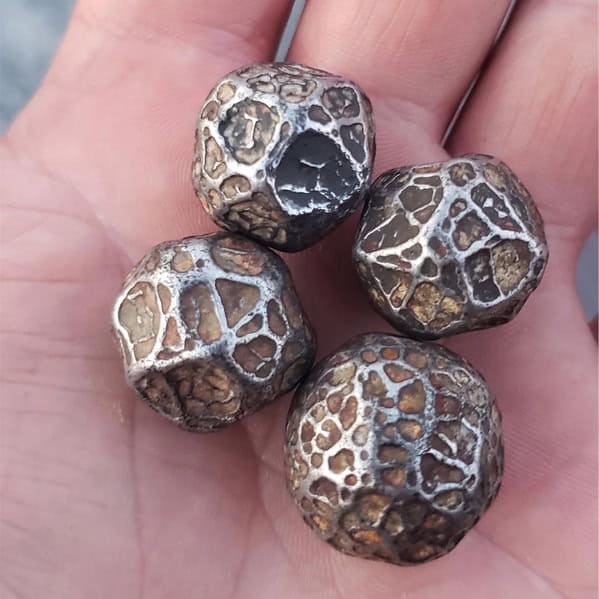
Mystery Solved:
They’re actually taconite pellets. Man-made iron ore balls used in steelmaking.
The pellets start off smooth and dark with a metallic sheen, but over time they oxidize and develop organic-looking patterns and rusted pits.
While they can be mistaken for natural mineral nodules or even industrial ball bearings, the size, density, and surface weathering line up with taconite.
7. “Found amongst assorted things. What appears to be a gold or bronze colored material in the tube, numbers on inner ring.”
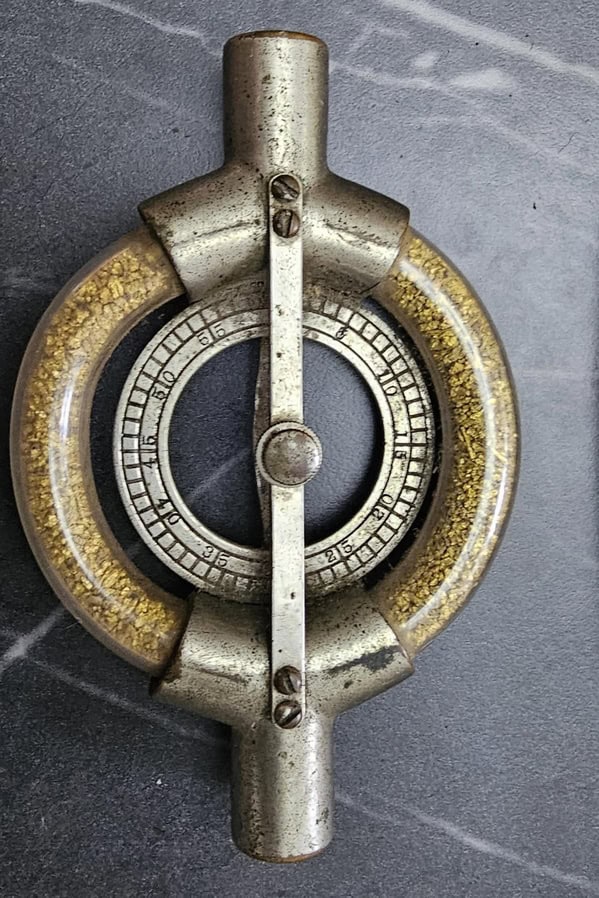
Mystery Solved:
This is a Spanish dip needle, also known as a Miner’s or Forester’s compass.
It’s a specialized magnetic instrument used to detect variations in the Earth’s magnetic field. Prospectors relied on it to locate deposits of strongly magnetic minerals. Mainly iron ores like magnetite or hematite.
As the needle tilts in response to magnetic anomalies underground, it gave early miners a low-tech but effective way to zero in on ore bodies long before modern surveying tools.
8. “Vintage flat plastic sheet with rows of uniform pyramidal protrusions. Matching red tool with wheel with opposite pyramidal shapes.”
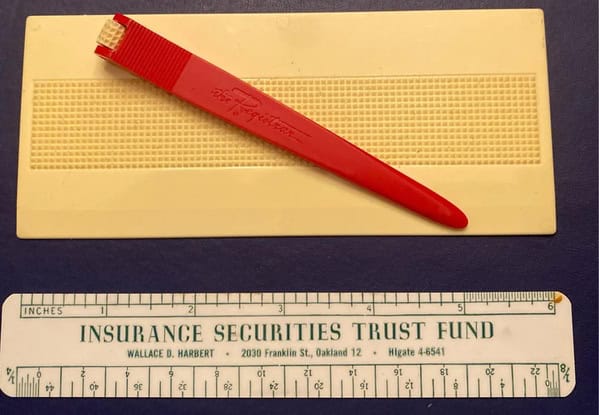
Additional Details:
Found in my late uncle’s desk drawer. Thought it might be for connecting two layers of paper, but it’s terrible for that purpose. The google thinks it’s a latch hook for crafting, which it clearly is not.
The two items definitely go together. Red tool wheel matches shape perfectly of white board. What is it?
Thanks!
Mystery Solved:
It’s a Registrar Check Protector, a vintage device used to emboss checks with the payee and amount. The raised imprint made it harder to alter or forge checks before digital banking existed.
9. “Trailer sized measuring device spotted on route 28B near Urubamba, Peru a few weeks ago”
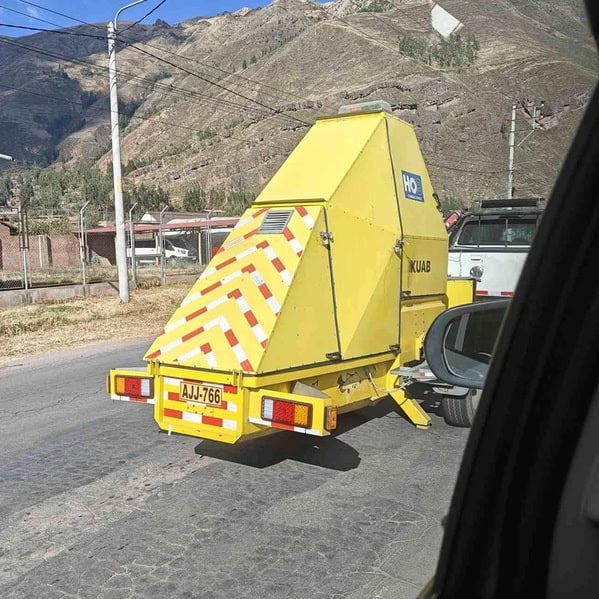
Additional Details:
They stopped every 500-1000m and a central leg came down and lifted the yellow part free of the grey trailer.
After a few minutes the leg retracted and they drove on the the next point.
I’m assuming it’s a measuring device of some sort but I don’t actually know
Mystery Solved:
That big yellow trailer is a Falling Weight Deflectometer (FWD) made by KUAB. It’s a non-destructive testing device used in road and pavement engineering.
The machine drops a heavy weight onto a load plate placed on the pavement, then sensors measure how much the surface deflects.
Engineers use this data to evaluate the structural condition of roads, runways, and highways, detect voids beneath the surface, plan maintenance, estimate pavement life, and check the quality of construction work.
10. “Protruding wooden furnishing found in old empty living room”

Additional Details:
I saw this unusual furnishing in an old empty living room that hadn’t been refurbished in decades. I’m curious as to what it is / what it would have been used for? It protrudes out of the corner wall (its position is most visible in photo 3).
The large matching wooden panel beside it is covering up a large radiator that’s fixed against the wall, but the furnishing itself doesn’t seem to be connected to the radiator and isn’t heated. Many thanks in advance for any ideas!
Mystery Solved:
Those tub-like wooden boxes are indoor planters built to match the room’s paneling. They were often paired with radiator covers in older homes, letting people keep decorative plants in the living space without clashing with the interior design. The radiator cover hides the heating unit, while the planter boxes were purely ornamental, meant for soil and greenery rather than storage or seating.
11. “Salt-like Substance that appears to be coming from my PC tower”
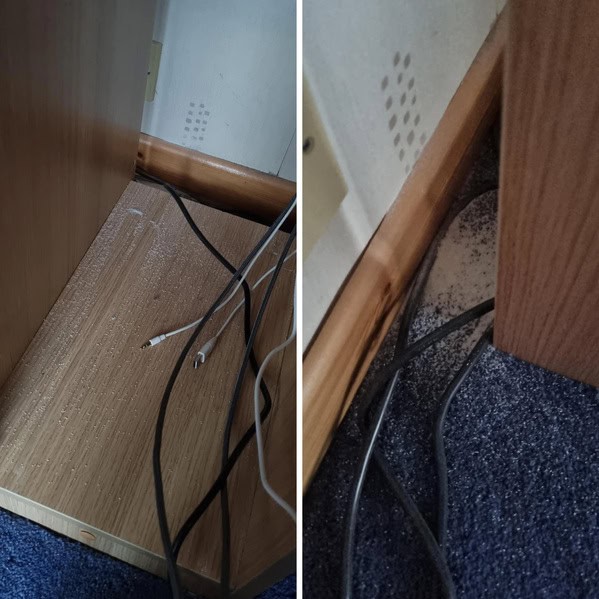
Additional Details:
For the last couples of weeks I’ve noticed a strange sound coming from my PC tower when I knock my desk, like one of those rainmaker toys from when I was a kid. Peering inside the tower I couldn’t see anything out of the ordinary but just now as I’ve adjusted the position of the tower, I’ve noticed an abundance of what appears to be some kind of salt-like substance. Any idea what this is and how to prevent it?
It may be worth noting that I’ve been gaming on my PC more in the past few months so the GPU is probably getting a little bit more use than it otherwise has.
Mystery Solved:
The “salt-like” dust by the desk wasn’t efflorescence or anything coming from the PC.
It turned out to be the leaking innards of a squishy stress ball that had deteriorated and burst.
12. “This 4×2 metal thing fastened to the leg or underside of each desk in an office building”

Mystery Solved:
That panel with the slotted metal plates is part of an old security bracket system used to lock down desktop computers and other office equipment. Long rods and locking cams would secure the CPU tower (or even typewriters back in the day) to the desk so they couldn’t be stolen.
It’s a retro piece of IT security hardware from the era when physically locking down equipment was as important as password-protecting it.
13. “Small glass flasks with long slanted tube? Goodwill find that has me stumped…”
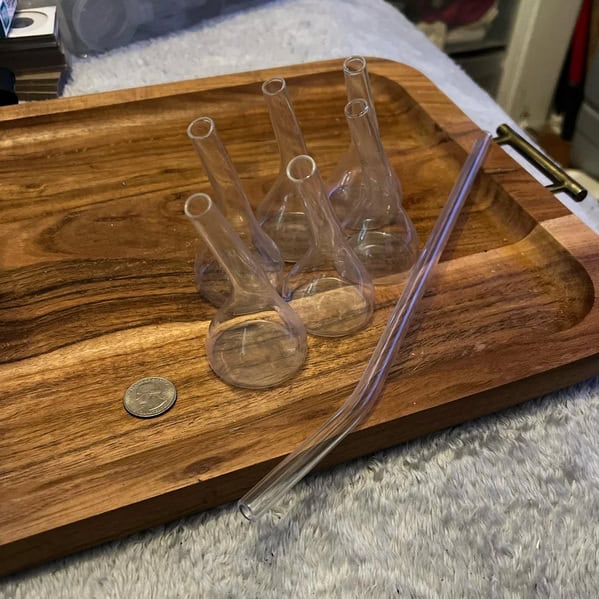
Additional Details:
It came with 6 of them and the tube. No idea what they are for but they were intriguing enough that I had to find out. Quarter in photo for size reference.
Mystery Solved:
The glass pieces turned out to be pretty simple…the long slanted tubes are reusable drinking straws, and the small ones are bud vases meant to hold a single flower. They only ended up together because of how they were grouped at Goodwill, not because they were originally a set.
14. “Blue plastic case with waxy feeling piece inside, smells like cologne”
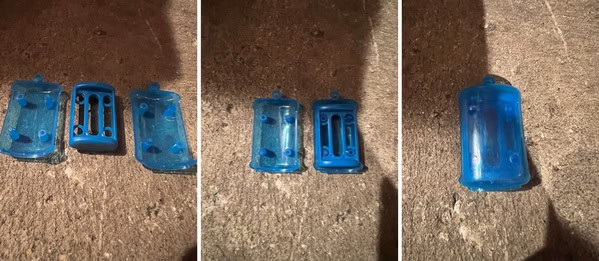
Mystery Solved:
Those little blue plastic pieces are the inner cartridges from a car air freshener. They look just like the refill packs used in products such as Yankee Candle Car Jars or similar clip-on air fresheners. The scented gel sits inside the casing, and once the fragrance is gone, you’re left with the empty plastic inserts.
15. “WW2 plane style plaque? Found on the beach, South Coast, UK”
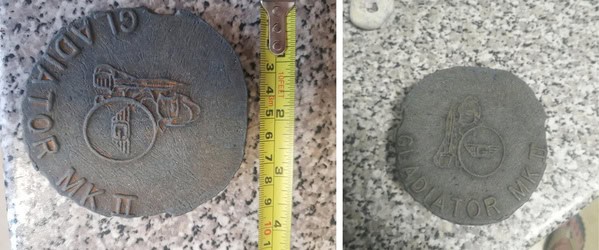
Additional Details:
Hey, I found this on the beach, well over 5 years ago and have been trying to find out where it came from since. I believe it’s a plaque of some sort from a Gloster Gladiator MKII plane?
After some research I believe some went down in the English Channel during WW2 so it makes sense for it to wash up along the south coast I’m unable to find a match anywhere or really anything to show me that it did come from a plane.
I’m hoping someone with some more knowledge would be able to identify this or help me out? Thanks
Mystery Solved:
The disc marked “Gladiator Mk II” refers to the Gloster Gladiator, the RAF’s last biplane fighter.
The winged “G” isn’t an official Gloster mark, so it was likely a unique badge from a specific aircraft, possibly from the cockpit or engine firewall.
A curator at the RAF Midlands Museum could confirm if it came from an actual Gladiator airframe or was later made as a display piece.
16. “Kitchen utensil from WMF, with sharp hook and curves”
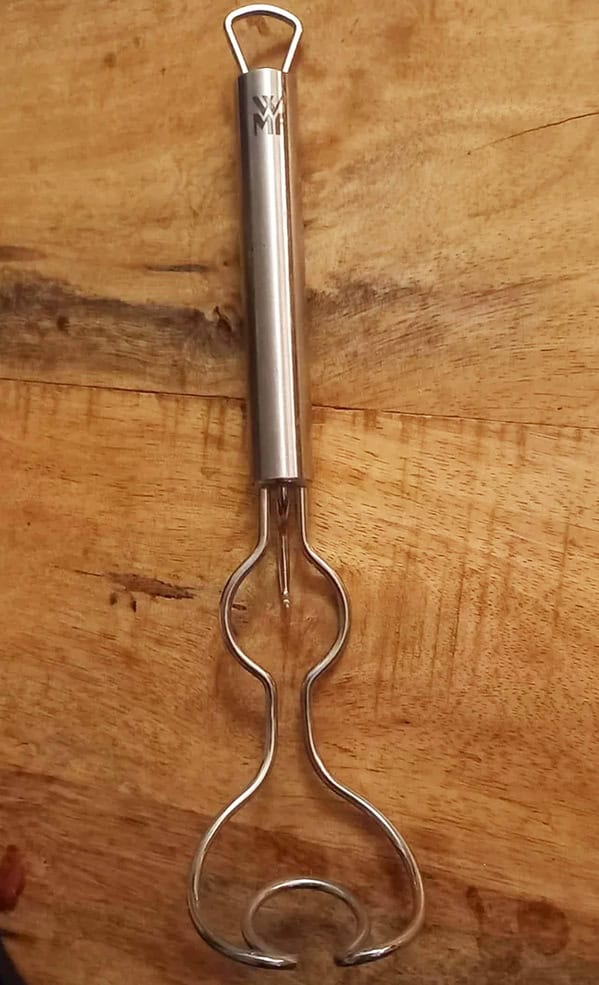
Mystery Solved:
It’s an egg boiler tool with two functions. The little spike at the top is used to pierce the shell of an egg before boiling, which prevents it from cracking. The wire loop at the bottom is a holder for lowering the egg into boiling water and lifting it back out safely once it’s cooked.
17. “Black silky fabric thing, about 5 feet long, found in our car. No memory of what it could be. Irregular but symmetrical shape. Has little weights/ magnets sewn in at several parts of the edge. Includes a drawstring bag. Could it go with a hammock or some other camping equipment?”
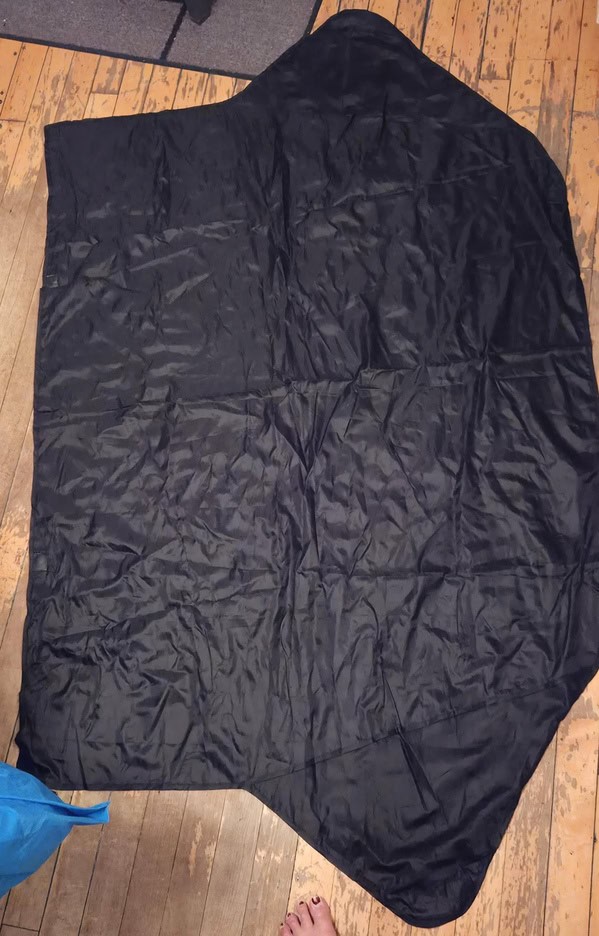
Mystery Solved:
Tt’s a windscreen cover with magnets. In winter, it keeps frost and snow off your windshield, and in summer, it works just as well to block direct sunlight and reduce heat buildup inside the car.
The flaps tuck into the doors so it doesn’t blow away, and the magnets help hold it in place across the roof and hood.
18. “Found at Goodwill. Small fits in palm. Ceramic. Can’t make out markings on bottom.”

Additional Details:
I’m thinking this was a ceramic student’s work and something super unique to them. I’m unsure what it is supposed to be? The end piece that sticks out has a hole through it as if a string or something is intended to be looped through it. I’m unsure what the slit on the side is for?
I thought it was fun and weird. Going to use as a pot of an air plant.
Mystery Solved:
This little pottery piece is an egg separator.
You crack a raw egg into the top, the yolk stays inside the cup, and the whites run out through the spout on the side.
19.
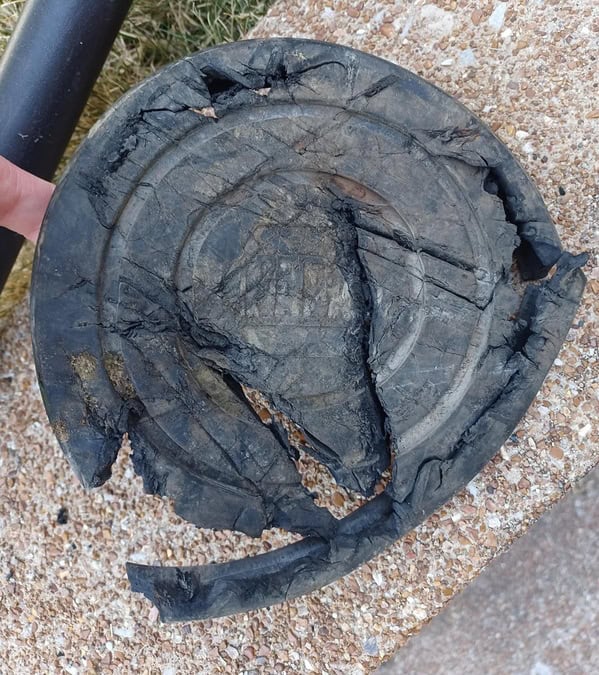
Additional Details:
I think it says NAPA, so I assume it’s a car part. Google Lens wasn’t helpful.
I’m just trying to figure out if this came off of her CR-V somehow or if she hit it on the highway. I found it under the passenger side door, and it’s about 10″ wide.
The car was in the shop last week, but it was for some work on the front of the engine.
Mystery Solved:
This shredded rubber piece is a pad from a floor jack or a two-post vehicle lift. These pads sit between the metal jack/lift and the car’s frame to prevent damage while lifting.
Over time they get cut, gouged, and cracked from the weight and pressure, which gives them that chewed-up, layered look you see here.
20. “Item is about the size of a hand, with 2 blades and a red handle. One blade is serrated with a large hump on the back. The other is not serrated. Found in the utensil drawer.”

Mystery Solved:
This is a pear canning tool, invented by Dean G. Ray around 1932 to make preparing pears faster and easier for canning.
The slit on the back works as a peeler, while the two shaped sides are used for coring and removing blemishes from the fruit.
It was patented under US1907582A and became a staple in canneries and home kitchens for processing pears.
The one in the photo is one of the later, mass-produced versions with a plastic handle, while older models often had wooden handles.
21. “Magnetic pucks with what appears to be a 1/2 turn locking device on top”
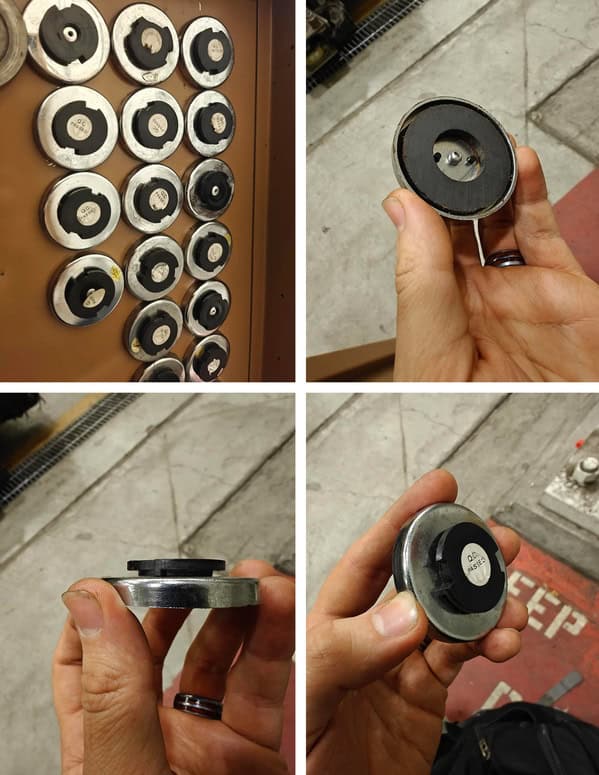
Additional Details:
I somewhat recently started a new job, and we have these things all over the shop but I have no idea what for.
The magnet is glued into the metal housing that has a plastic piece riveted to the top.
This plastic piece has two cut outs and looks like something is supposed to attach to it with a 1/2 turn. Any ideas? Google lens was no help.
Mystery Solved:
These discs are the magnetic bases for blue flag lights used in railroad operations.
Blue flag protection is a safety system. Placing a blue flag or light on a locomotive or track signals that workers are inspecting, repairing, or servicing equipment, and the train cannot be moved.
The heavy magnets hold the light firmly to the locomotive or railcar, ensuring it stays in place while crews are working.
22. “Yarn sewn through plastic grids to make a shape. Has a hole at the bottom and has a hatch at the top”
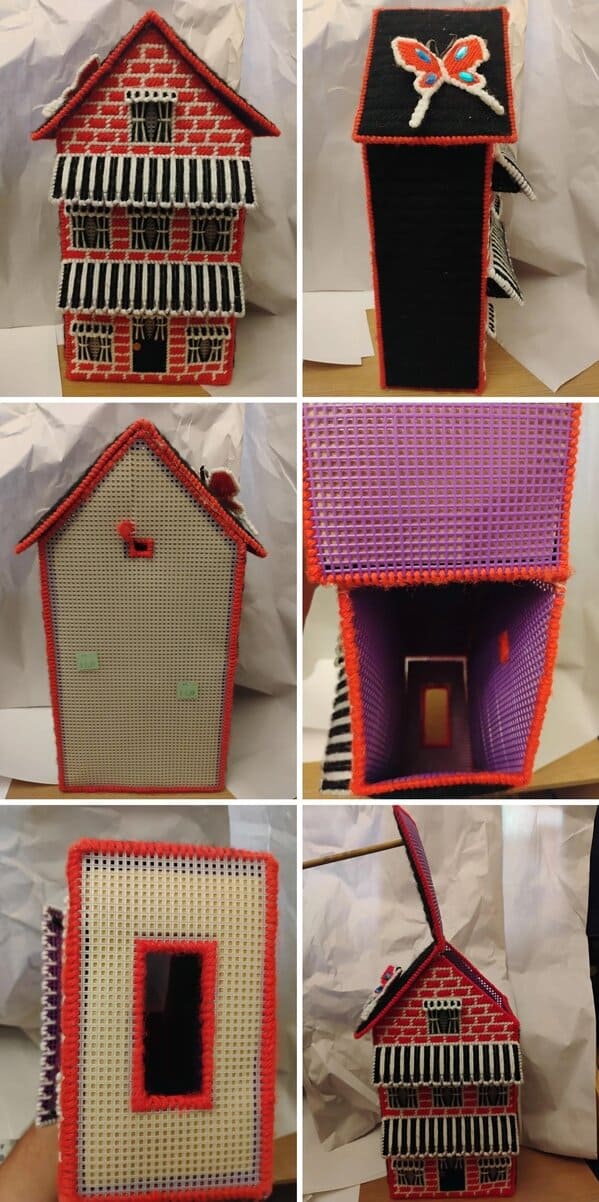
Mystery Solved:
This is a plastic canvas needlepoint bag holder, often made as a decorative craft. It’s designed to hang on the wall, with grocery bags loaded in through the flap on top and dispensed one at a time from the opening at the bottom. A clever handmade way to store and reuse plastic shopping bags while doubling as home décor.
23. “Small metal thing found while gardening, quite heavy, ‘2411’ on the end”
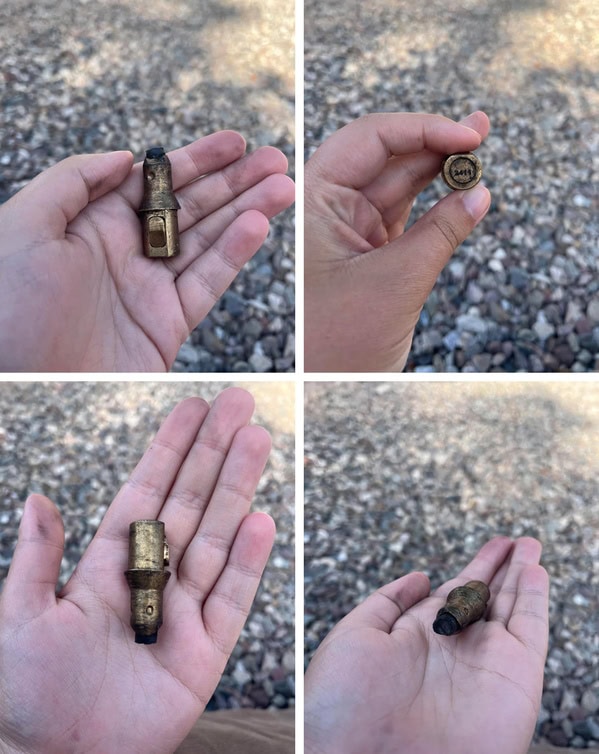
Mystery Solved:
This brass piece is a connector from a chimney cleaning rod system. The rods screw or snap together to reach deep inside a chimney, and this fitting locks the brush head or additional rod in place. The rugged design and numbering help keep the sections aligned and secure while the brush is rotated to scrape soot and creosote off the chimney walls.
24. “We found this item in a used Motorhome, can anyone tell us what it is. It’s metal, weighs a few ounces.”
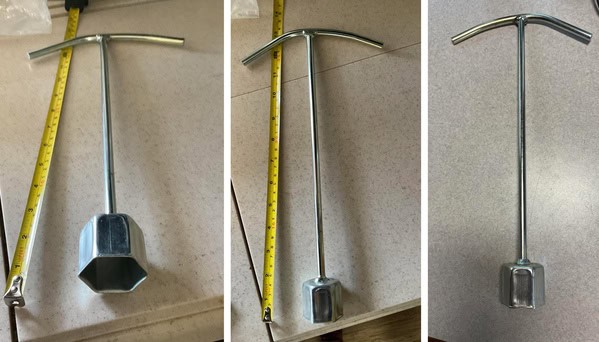
Mystery Solved:
This tool is a removal wrench for decorative wheel lug nut covers (wheel simulators), like the stainless-steel sets used on trucks and RVs. The large hex socket slips over the lug nut cover, and the long T-handle gives leverage to twist them off without damaging the chrome or stainless finish. It’s not for actual lug nuts. It’s just for the decorative covers that sit over them.
25. “Large metal assembly spotted in far northern Minnesota”

Additional Details:
Spotted this at Tettegouche State Park on Minnesota’s Lake Superior North shore. Stampings on the side indicate that it was made in Turkey, possibly carried over by ship to the Port of Duluth? Looks like something for a hydroelectric plant, or mining on the iron range maybe?
Mystery Solved:
The massive piece of equipment on the trailer is part of a Symons/Nordberg heavy-duty cone crusher, used in mining and aggregate industries to crush rock into smaller material.
This particular section is the crusher head or bowl assembly, which houses the internal components that grind and break down ore or stone.
These units are built to handle extremely hard rock and high-volume production, and the markings on the casting confirm it was manufactured in Turkey for industrial use.

